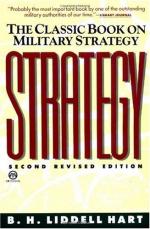
|
| Name: _________________________ | Period: ___________________ |
This test consists of 15 multiple choice questions and 5 short answer questions.
Multiple Choice Questions
1. During the British Civil Wars, what were the prospects for sweeping victories and conquests?
(a) They were limited.
(b) They were unlimited, given enough time.
(c) The author could not comment on the prospects.
(d) They were unlimited, given enough resources.
2. In what way did Caesar excel as a general?
(a) In battles in unusual and difficult terrain.
(b) In set-piece battles on open plains.
(c) At sapping the morale of enemy forces.
(d) At destroying enemy armies wholesale.
3. According to the indirect method, which of the following routes should be taken in order to engage the enemy?
(a) The route that confuses the enemy most.
(b) The fastest possible route.
(c) A circuitous route that provides an advantage in terrain or position.
(d) A direct route that is difficult to disrupt.
4. According to the author, which of the following strategies have been known and used by intelligent generals dating back to ancient times?
(a) Building fortifications.
(b) False retreats.
(c) Avoiding bloodshed and battles.
(d) Concentration of forces.
5. During William of Normandy's time, what was the state of military strategy?
(a) It was in decline.
(b) It was almost totally forgotten.
(c) It was unpopular for being unchivalrous.
(d) It was improving greatly.
6. Who led the second Persian invasion of Greece?
(a) Xerxes.
(b) Belasarius.
(c) Themistocles.
(d) Darius the Great.
7. The author suggests that which of the following can easily become involved in grand strategy?
(a) Race.
(b) Organized labor.
(c) Religion.
(d) Industry.
8. Which country became noted as a major world power for the first time during the First World War?
(a) United States of America.
(b) Russia.
(c) Prussia.
(d) China.
9. How does the author define "Generalship"?
(a) The chain of military command.
(b) The actual directing of military forces.
(c) The respect received from the troops.
(d) The dominating force of leadership of a commander.
10. One of the aphorisms introduced at the beginning of the book states that all warfare is based on what?
(a) Strength.
(b) Government.
(c) Deception.
(d) Power.
11. After the second war with Persia, Greece secured about how many years of peace and freedom from the Persians?
(a) Two hundred.
(b) Five hundred.
(c) Ten.
(d) Seventy.
12. Why did Caesar prefer to win battles and campaigns with as little bloodshed as possible?
(a) He wanted to turn defeated opponents into followers.
(b) He wanted to preserve his own troops at all costs.
(c) He wanted to avoid unneccesary killing for religious reasons.
(d) He was orderly and disliked "messy" battles.
13. When moving to engage the superior Scottish forces, what was the nature of Cromwell's overall strategic maneuver?
(a) A slow inexorable creep that avoided major confrontations.
(b) Cromwell did not use a strategic maneuver.
(c) An indirect sweeping movement made while gathering supplies.
(d) A lightning offensive that relied on seizing the enemy's supplies.
14. The principle of mobility applies to units on what scale?
(a) Division-level scales.
(b) Platoon-level scales.
(c) It applies on all scales.
(d) Corps-level scales.
15. Who was Caesar's main opponent throughout most of his campaigns?
(a) Cleopatra.
(b) Pompey.
(c) Hannibal.
(d) The Spartans.
Short Answer Questions
1. Which of the following was a widely-used tactic in William of Normandy's time?
2. What is the author's assessment of the strategies employed in the the First World War?
3. According to the indirect method, which of the following is true regarding attacks on enemy resources and psychological conditions?
4. About how many men was Belisarius given with which to conquer the Vandals?
5. How did Caesar achieve relatively bloodless victories?
|
This section contains 623 words (approx. 3 pages at 300 words per page) |

|




